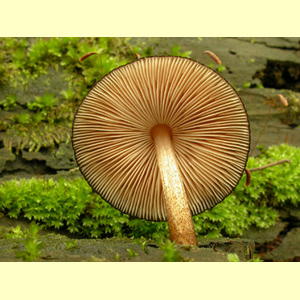
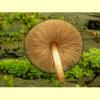
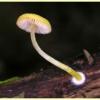
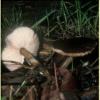
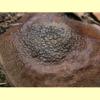
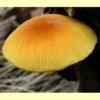
_AL_27_sml.jpg)
NOTE IN PROOF: Pluteus aff. fenzlii, which is unusual in having a distinct annulus, has recently been reported from Queensland (Prance, 2013).
Bougher, N.L. (2011), New records of fungi and slime moulds at Kings Park, Perth, Western Australia, W. Austral. Naturalist 28: 24–42. [Illustration of P. perroseus]
Bougher, N.L. & Syme, K. (1998), Fungi of Southern Australia. University of Western Australia Press, Nedlands. [Description, Illustration and Microcharacters of P. atromarginatus]
Breitenbach, J. & Kränzlin, F. (eds) (1995), Fungi of Switzerland. Volume 4. Agarics 2nd part. Edition Mykologia, Lucerne. [Description, Microcharacters and Illustration of P. cervinus and P. romellii from Europe]
Fuhrer, B. (2005), A Field Guide to Australian Fungi. Bloomings Books, Hawthorn. [Description and Illustration of P. atromarginatus, P. cervinus and P. romellii (as P. lutescens)]
Grgurinovic, C.A. (1997a), Larger Fungi of South Australia. The Botanic Gardens of Adelaide and State Herbarium and The Flora and Fauna of South Australia Handbooks Committee, Adelaide. [Description and Microcharacters of P. cervinus, P. muscorum and P. nanus (but more likely is P. romellii due to yellow stipe), along with Illustration of P. cervinus and Key to South Australian species]
Hood, I.A. (2003), An Introduction to Fungi on Wood in Queensland. University of New England, School of Environmental Sciences and Natural Resources Management, Armidale. [Description and B&W Illustration of P. aff. cervinus]
Horak, E. (1983a), Mycogeography in the South Pacific region: Agaricales, Boletales, Austral. J. Bot., Suppl. Ser. 10: 1–41. [Description and Microcharacters of P. pauperculus (as P. flammipes var. depauperatus) and P. perroseus]
Horak, E. (2008), Agaricales of New Zealand. 1: Pluteaceae (Pluteus, Volvariella); Entolomataceae (Claudopus, Clitopilus, Entoloma, Pouzarella, Rhodocybe, Richoniella). Fungi of New Zealand Volume 5. Fungal Diversity Research Series 19. Fungal Diversity Press, Hong Kong. [Description, B&W Illustration, Microcharacters and Key for P. pauperculus and New Zealand collections of P. perroseus]
Hubregtse, J. & Hubregtse, V. (2011), Preliminary observations on an undescribed yellow Pluteus species, Vict. Naturalist 128: 111–115. [Illustration, Description and Microcharacters of Pluteus sp. 'yellow']
McCann, I.R. (2003), Australian Fungi Illustrated. Macdown Productions, Vermont. [Illustration of P. atromarginatus, P. cervinus and P. lutescens, and an unidentifed species]
Orton, P.D. (1986), British Fungus Flora. Agarics and Boleti. 4 / Pluteaceae: Pluteus & Volvariella. Royal Botanic Garden, Edinburgh. [Description, B&W Illustration and Microcharacters of P. atromarginatus, P. cervinus, P. pellitus, P. romellii and P. villosus]
Young, A.M. (2005b), A Field Guide to the Fungi of Australia. University of New South Wales Press, Sydney. [Description and B&W Illustration of P. aff. atromarginatus and P. cervinus]
Prance, M. (2013), Mt. Cordeaux Foray, 16 Feb. 2013, Queensland Mycol. 8(1): 7-9 [Illustration of P. aff. fenzlii]
